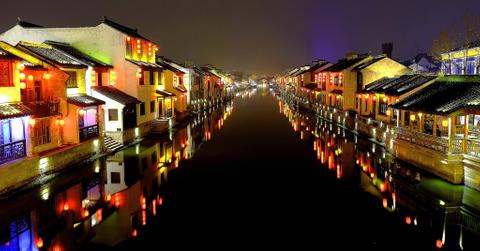This Province In China Just Went An Entire Week Running Only On Renewable Energy
A number of places have been able to successfully run on 100 percent renewable energy, and the Qinghai province in China joins the list after successfully completing a test run for one week. Around 72 percent of their energy came from hydropower.
Updated May 24 2019, 4:06 a.m. ET
Don’t believe that we can run solely on renewable energy? While it certainly presents some challenges, there’s been successful trial runs around the world. European countries have been making headlines running on 100 percent renewable energy for at least 24 hours, and Portugal was successful on four consecutive days a year ago. One province in China was able to last an entire week.
According to reports from Xinhua News, the Qinghai province in China had all 5.8 million residents living on hydro, wind, and solar power between June 17th and the 23rd. Over 1.1 billion kilowatt hours were required to meet energy demands in the area, and most of that (72 percent) came from hydropower.
Energy capacity through these renewable sources are at 23 million kilowatts, which will likely make it up to 35 million within the next three years. If that’s the case, up to 110 billion kilowatt hours can be generated from alternative sources. That would be more than enough to meet electricity demands in Qinghai it would be used in other local areas in China.
Being powered solely on renewable energy saved over 535,000 metric tons of coal being burned. The province gave it a chance after 83 percent of their energy was generated from sustainable sources back in May. It turned out to be very successful, showing that their energy grid was able to work properly with the fluctuations in wind and solar generation.
Han Ti, Vice General Manager of the Qinghai’s power grid, provided statistics in the news report and also released a statement on the success: "Clean energy is the ultimate way. We need to reduce reliance on fossil fuel, improve our energy structure, and reduce carbon emissions." Li Yuzhong, General Manager of the grid, said that transferring over to fully renewable energy “was a smooth process.”
It’s worth noting that hydropower is more controlled than wind and solar energy. For this method, water is usually stored in a reservoir and flows through a power plant, moving turbines that produce electricity. The Qinghai province is located at the headwaters of the Yellow and Yangtze Rivers, creating around three-fourths of the total renewable energy.
Other benefits this location has is sparse population and being on a plateau. With less people per square mile, that creates less pull on the electrical grid. This area can become baked with sunlight, and it’s the reason why an 850-megawatt solar farm was installed in this province. These ideal conditions made it a perfect area to test out a larger population running solely on renewable energy.
The biggest takeaway is the power grid’s ability to run without a hitch despite energy generation fluctuating. It gives promise to a future where battery facilities will be able to store this energy and fuel the electrical grid when solar and wind power isn’t available or don’t have ideal conditions like in Qinghai. The entire country of China has a goal set to generate 20 percent of its energy from clean sources.
